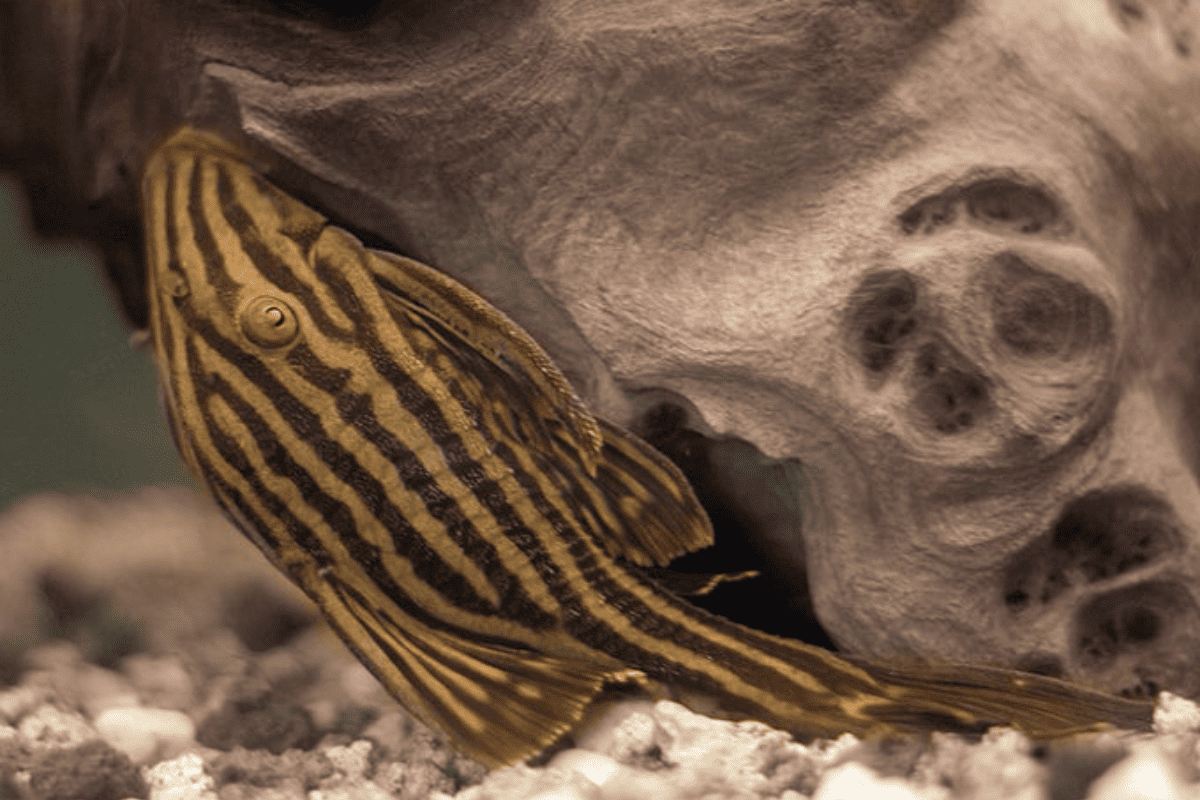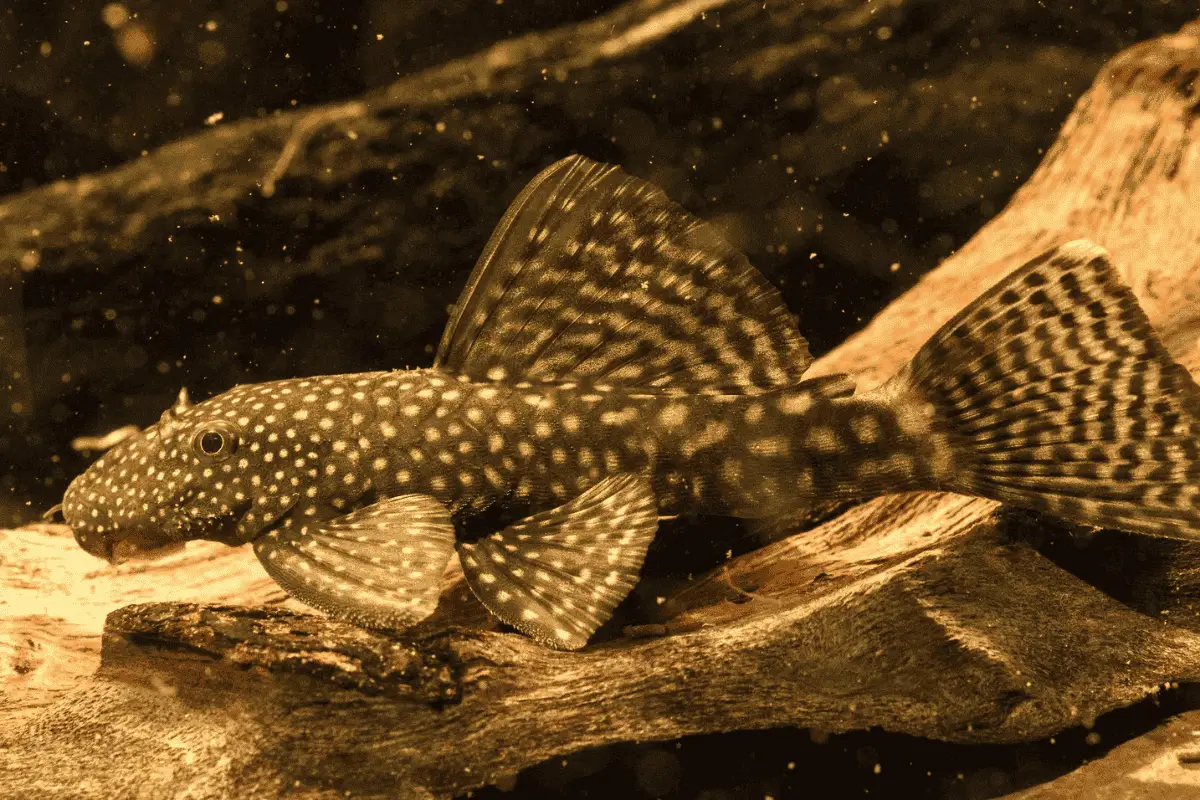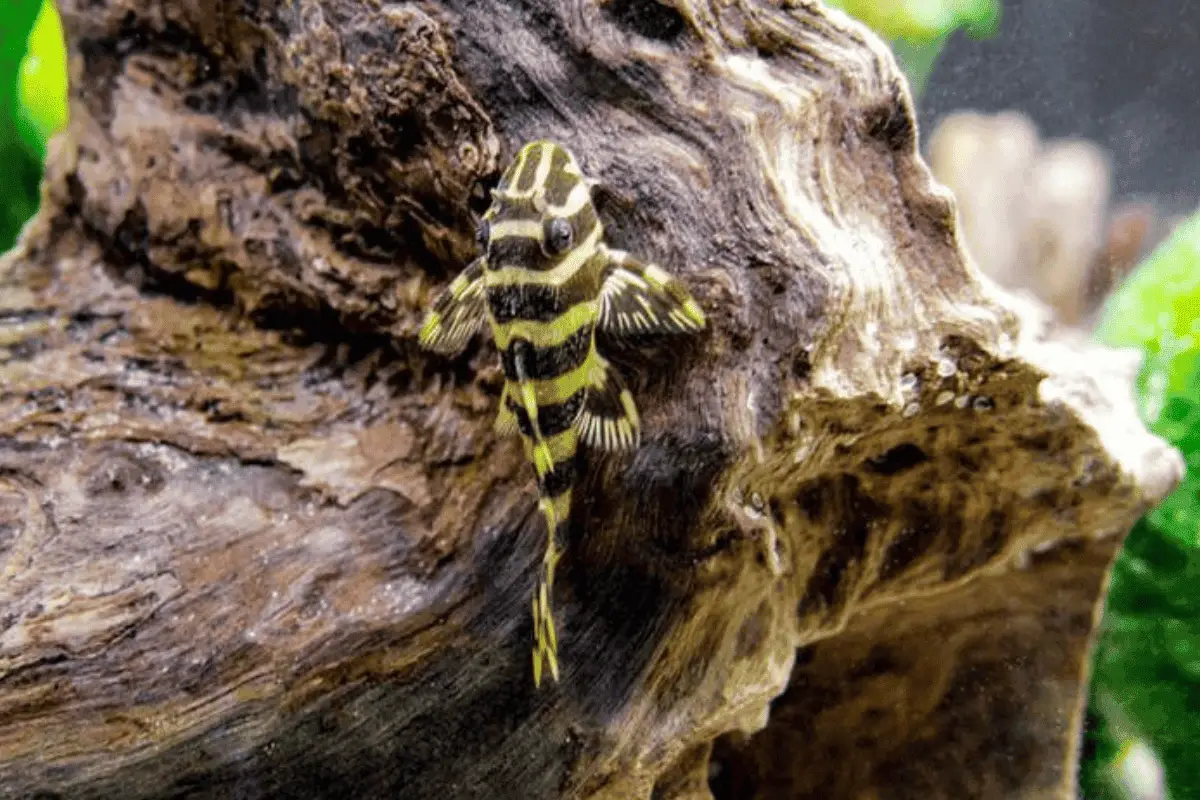Raising Plecos in a tank is pretty straightforward, as these creatures know how to take care of themselves. However, they do need your intervention from time to time.
Today, I’ll talk about driftwood and its role in Plecos’ life.
Is it necessary? Can some species live without it? How do you introduce it properly? What are some maintenance tips? Here, I’ll address all that and a lot more.
Let’s get started.
Also Read: Pleco Fish Tank Setup

Do Plecos Need Driftwood?
Yes, plecos often benefit from driftwood in their tanks.
Driftwood provides them with essential fibers they ingest while rasping, aiding in digestion. Additionally, it offers a natural environment and hiding spot.
Here are the main benefits of having driftwood in your Pleco tank:
1. Natural Diet Source
In the wild, Plecos graze on driftwood surfaces, deriving essential nutrients from the biofilm and algae present.
This process also allows them to consume bits of wood, providing unique dietary components.
- Algae Consumption: Plecos love to scrape off and consume the algae that naturally grows on the surface of driftwood.
- Biofilm Source: Aquarium driftwood forms a biofilm layer that Plecos find both tasty and beneficial to their diet.
- Woody Component: While Plecos aren’t mainly wood-eaters, they do consume tiny wood fragments as a part of their natural diet.
2. Digestive Aid
When some Pleco species eat wood, it helps their digestion by supplying key fibers. This not only maintains their gut health but also keeps them lively and energetic.
- Fiber Intake: Eating driftwood gives Plecos the fibers they need, leading to a well-functioning digestive system.
- Activity Stimulation: Gnawing at the driftwood keeps Plecos active, which in turn supports improved digestion.
- Prevention: Lack of wood might lead to digestive issues in some Pleco species, emphasizing its importance in their diet.

3. Shelter and Security
Driftwood formations provide Plecos the perfect hiding spot, giving them a feeling of safety. These small spaces mimic the gaps they’d naturally find in their wild environment.
- Stress Reduction: A cozy hideout such as driftwood helps reduce stress in Plecos, leading to improved health.
- Territoriality: Plecos can be territorial; driftwood provides distinct boundaries, reducing conflicts with tank mates.
- Mimicking Nature: In the wild, Plecos are known to hide under logs and stones; driftwood in the aquarium replicates this environment.
4. Breeding Ground
For reproducing Plecos, driftwood plays a crucial role in their mating practices. Certain species prefer laying eggs on the wood’s underside, using it as a protective nesting site.
- Egg Adhesion: The rough surface of driftwood allows Plecos’ eggs to adhere firmly, ensuring they remain secure.
- Protection: Driftwood provides a secluded area, keeping the eggs safe from potential predators in the tank.
- Breeding Success: For many aquarists, introducing driftwood has led to increased breeding success among their Pleco populations.

5. Natural Habitat Simulation
Driftwood plays a significant role in replicating the natural riverbeds and streams where Plecos originate. It introduces a touch of nature, enhancing their well-being.
- Behavioral Benefits: Observing Plecos in a setup with driftwood will show more natural behaviors, as they feel “at home.”
- Water Chemistry: Driftwood releases tannins that can slightly acidify the water, mimicking the blackwater habitats some Plecos come from.
- Aesthetic Value: For the aquarist, driftwood not only benefits the Plecos but also adds a beautiful, natural touch to the aquarium’s landscape.
6. Tank pH Balance
Driftwood naturally releases tannins into the water, which can have a slight acidifying effect. This is beneficial for many Pleco species that are native to softer, more acidic waters.
- Water Conditions: Driftwood tannins can reduce pH levels, creating a more natural environment for some Pleco species, which helps them relax.
- Water Hue: These tannins lend a gentle tea-like hue to the water, resembling the natural blackwater homes of certain Plecos.
- Chemical Stability: When Plecos get used to the driftwood-colored water, they often exhibit better health and reduced stress.

7. Enrichment and Engagement
Driftwood provides a rich environment for Plecos to explore, keeping them mentally and physically active. It adds intrigue and excitement to their tank life.
- Mental Engagement: Navigating through driftwood’s twists and turns keeps Plecos mentally sharp.
- Physical Movement: Plecos often graze on driftwood, ensuring they remain physically active, crucial for their health.
- Dynamic Setting: You can set up driftwood in multiple layouts, presenting varied climbing and hiding spots, amplifying Plecos’ daily adventures.
8. Natural Territorial Boundaries
Plecos are territorial in nature, especially about their preferred grazing areas. Aquarium driftwood lets them set and mark their unique zones.
- Lesser Conflicts: Having several driftwood pieces can notably decrease territorial disputes among tank Plecos.
- Scent Marking: Plecos frequently brush against driftwood, marking their territory with a distinct scent, reinforcing their sense of place.
- Personal Zones: Each Pleco can stake a claim to a driftwood section or piece, ensuring harmony among the tank’s residents.
9. Managing Mouthparts and Teeth
Plecos’ mouths are adapted for grazing, and in a tank, they can grow excessively if not used. Driftwood assists in naturally trimming them.
- Dental Care: Regular grazing on driftwood prevents Plecos’ teeth from growing too much, mitigating potential health risks or the need for human interference.
- Natural Wear: In the wild, the rasping action on wood and other hard substances naturally keeps Plecos’ mouthparts in good condition.
- Preventive Care: Regular use of driftwood can help to avoid mouth and dental issues, reducing the overall healthcare needs for your Pleco.

Can Plecos Live Without Wood?
Yes, Plecos can survive without wood in their tank, but it’s not the optimal environment for their overall well-being.
While they can get nutrients from other sources, the absence of wood might deprive them of certain essential dietary components and comfort.
- Dietary Components: Plecos can find alternative food sources in the tank, but without wood, they miss out on beneficial fibers that aid digestion and provide natural nourishment.
- Stress Levels: Driftwood offers Plecos a sense of security and shelter; without it, they may feel more exposed, which can elevate their stress levels, potentially leading to health issues.
- Natural Behavior: Plecos instinctively rasp at driftwood in the wild. Without it, they might lack some natural stimulation, which could impact their overall contentment and activity levels.
What Type of Driftwood Is Best for Plecos?
For Plecos, the best driftwood is the type that provides ample surface area for rasping, is dense enough to sink, and releases tannins gradually.
Bogwood, Mopani wood, and Malaysian driftwood are among the popular choices for aquarists.
- Bogwood: This is a dense, dark wood that sinks easily. Plecos love it not just for its texture, but also for the ample surface area it provides for feeding and rasping.
- Mopani Wood: Known for its two-tone coloration, Mopani is not only aesthetically pleasing but is also dense and sinks readily, making it a great choice for Plecos in terms of both form and function.
- Malaysian Driftwood: This wood is favored for its longevity underwater and its natural ability to lower pH levels. Plecos thrive with this type of driftwood due to its structure, which allows for excellent rasping and hiding spots.
My recommendation: Dr. Moss Malaysian Driftwood (link to Amazon).
What to Think About When Picking Driftwood for Plecos?
When choosing driftwood for Plecos, it’s essential to consider its size, type, shape, and safety for the fish.
You want to ensure it complements the tank’s size while offering ample rasping and hiding opportunities for your Plecos.
- Size and Scale: The driftwood should fit comfortably in the tank without overcrowding it. It’s essential to ensure that Plecos have enough space to swim around and explore freely.
- Types of Wood: Different driftwoods have different qualities. For instance, Bogwood and Mopani are dense and sink easily, ideal for Plecos’ rasping activities.
- Safety Check: The driftwood should be free from sharp edges or points that might harm the Plecos. Always inspect each piece for potential hazards.
- Tannin Release: Some driftwood types release tannins more than others. Knowing this helps aquarists anticipate potential water discoloration and pH shifts.
- Aesthetic Appeal: While the primary goal is Plecos’ well-being, it’s also good to choose a piece that complements the overall look of your aquarium, enhancing its visual appeal.
How to Add Driftwood to a Pleco Tank Properly?
Before placing driftwood in a Pleco tank, it’s vital to prepare and position it correctly.
This ensures the safety and well-being of your Plecos while also enhancing the aesthetics of the tank.
- Cleaning First: Always clean the driftwood thoroughly, scrubbing away any dirt or debris. Rinsing with clean water helps remove contaminants that might harm your Plecos.
- Soaking: Driftwood often floats initially. Soak it in water for a week or until it sinks. This process also helps release excess tannins, reducing the discoloration of tank water.
- Boiling: If feasible, boiling smaller pieces of driftwood can help kill any potential parasites or pathogens. It also speeds up the tannin release process.
- Positioning: Once in the tank, position the driftwood to offer Plecos the best rasping surfaces and hiding spots. Ensure stability so it doesn’t shift and potentially harm your fish.
- Monitor Water Parameters: After introducing driftwood, keep an eye on the water’s pH and color. Adjustments might be needed based on the tannin release to keep conditions optimal for Plecos.

Driftwood Alternatives for a Pleco Tank
While driftwood is a preferred choice for many Pleco tanks, there are several alternatives that can also cater to Plecos’ natural behaviors and needs.
These alternatives can provide rasping surfaces, hiding spots, and a visually pleasing environment similar to driftwood.
- Ceramic Ornaments: Many ceramic ornaments are designed specifically for fish tanks. They offer smooth surfaces for Plecos to rasp on without the risk of splinters and can be shaped to provide hiding spots.
- PVC Pipes: These can mimic the hiding spots and tunnels that driftwood provides. They’re safe for Plecos and can be buried in substrate or positioned strategically for Plecos to retreat into.
- Stone and Rock Formations: Large, flat stones or slate can offer rasping surfaces for Plecos. Ensure they are smooth and free from sharp edges to keep your Plecos safe.
- Coconut Shells: Halved and cleaned coconut shells can be a natural, biodegradable option. They provide a sheltered space for Plecos to hide and can also serve as rasping surfaces.
- Commercial Fish Hides: Available at pet stores, these are made of fish-safe materials and are designed to provide shelter and security, replicating the nooks and crannies Plecos love.
Also Read: Best Substrate for Plecos
Do All Pleco Species Need Driftwood?
Not all Pleco species require driftwood in their tanks, though many benefit from its presence.
The necessity of driftwood varies depending on the natural habitat and dietary preferences of the specific Pleco species:
| Pleco Species | Driftwood Necessary |
| Bristlenose Pleco (Ancistrus sp.) | Yes |
| Clown Pleco (Panaqolus maccus) | Yes |
| Royal Pleco (Panaque nigrolineatus) | Yes |
| Rubbernose Pleco (Chaetostoma milesi) | Yes |
| King Tiger Pleco (Hypancistrus spp.) | Yes |
| Blue Eyed Pleco (Panaque suttonorum) | Yes |
| Zebra Pleco (Hypancistrus zebra) | Yes |
| Snowball Pleco (Hypancistrus inspector) | Yes |
| Vampire Pleco (Leporacanthicus galaxias) | Yes |
| Gold Nugget Pleco (Baryancistrus xanthellus) | Yes |
| Sailfin Pleco (Glyptoperichthys gibbiceps) | No |
| Spotted Pleco (Hypostomus punctatus) | No |
| Common Pleco (Hypostomus plecostomus) | No |
| Butterfly Pleco (Dekeyseria pulchra) | No |
| Candy Striped Pleco (Peckoltia vittata) | No |
| Galaxy Pleco (Leporacanthicus heterodon) | No |
| Whiptail Pleco (Rineloricaria parva) | No |
| Rhino Pleco (Pterygoplichthys scrophus) | No |
| Sunshine Pleco (Scobinancistrus aureatus) | No |
| Marble Pleco (Hypostomus margaritifer) | No |

Driftwood Maintenance Tips for Plecos
To ensure your Plecos thrive, driftwood must be well-maintained, as it’s not only a decorative piece but also a functional element in the aquarium.
- Regular Inspection: Examine driftwood every 2 weeks, watching for soft spots or decay, ensuring it’s safe for Plecos.
- Remove Algal Growth: During monthly water changes, gently scrub away algae using a soft brush, preserving the wood’s rasping surface for Plecos.
- Water Changes: Change 10-15% of tank water weekly; this curtails tannin discoloration and ensures optimal water conditions for Plecos.
- Reposition Occasionally: Every month, alter driftwood’s position, exposing fresh rasping areas and adding variety for Plecos.
- Boil When Needed: For small-sized driftwood, boil once every few months to kill pathogens, ensuring a healthy environment for Plecos.
- Monitor Water pH: Track pH levels bi-weekly; driftwood may lower pH, so aim to keep it between 6.5-7.5, ideal for most Plecos.
- Limit Sun Exposure: Place your tank away from direct sunlight to prevent rapid algal growth, ensuring the wood remains accessible to Plecos.
Also Read: Do Plecos Need Light?

Conclusions
For those of you who are just skimming through, here’s a short recap:
- Driftwood is a crucial addition to Pleco tanks, providing a natural diet source, aiding digestion, and promoting algae consumption.
- It serves as a shelter, reducing stress and territorial conflicts while mimicking their wild habitat.
- Driftwood enhances breeding success, acting as a protective spawning surface for Plecos.
- By simulating natural riverbeds and streams, driftwood encourages natural behaviors and slightly acidifies the water, benefiting Plecos’ well-being.
- While Plecos can survive without driftwood, its absence may deprive them of essential dietary components, comfort, and natural stimulation.

